A few weeks ago, I started seeing advertisements for an upcoming Kickstarter campaign covering battles of the Roman Empire against her enemies in the 1st and 2nd centuries. The game is called ONUS! Traianus and is not a miniatures game but is using a similar style system but with cardboard formation counters rather than plastic miniatures. It looked intriguing and I reached out to the designer Luis Álvaro Hernández to see if he could share some background on the design.
If you are interested in ONUS! Traianus you can order a copy on the Kickstarter page at the following link: https://www.kickstarter.com/projects/dracoideas/onus-traianus?ref=2i102x&token=eaa40ec1
Grant: First off Luis please tell us a little about yourself. What are your hobbies? What’s your day job?
Luis: I am lucky to be able to devote myself full time to publishing. Work and family consume most of my free time, so I have little time left for my hobbies, playing board games, reading and history.
Grant: What motivated you to break into game design?
Luis: ONUS! Rome vs. Carthage was our first board game, that’s why we are so excited about the new installment that is ONUS Traianus, 8 years later. Like many of our titles, ONUS! was born as a board game that we would like to play and that didn’t exist (yet).

Grant: What designers would you say have influenced your style?
Luis: I think that every time we play a game, part of its creation process, of its mechanics, remains in our memory. We stand on the shoulders of giants, as the famous phrase goes, and every designer who publishes a game makes the world of board games bigger. So to answer your question, I would say lots of different designers but not one specifically.
Grant: What do you find most challenging about the design process? What do you feel you do really well?
Luis: The challenge is to make a game that is fun, easy to play up to a certain point and has historical rigor. For me, playing board games is to live experiences and that the game tells a story in each game. I feel that I have the ability to tell a story through the medium of board games.

Grant: What historical event does your upcoming game ONUS! Traianus cover?
Luis: The ONUS! Series deals with battles in Antiquity, starting with the Punic Wars. ONUS! Traianus moves forward to the 1st and 2nd centuries CE. It is the moment of maximum splendor of the Roman Empire and Trajan (Traianus in Latin) and Hadrian faced great military challenges, which we present in the game, especially the first and second Dacian War and the campaign against Parthia.
Grant: What does the name of the game mean and what image should it convey to gamers?
Luis: Traianus is the Latin name of the emperor Trajan. During Trajan’s time, Rome reached its greatest extent, reaching as far as India! This is a very interesting and exciting time in the history of the Empire and the game covers many of the major battles of the time.
ONUS is the Latin word for charging, so I thought it would be a very epic name for the game series.
Grant: This game is based on the same style as miniatures games. Why was that the model you used?
Luis: I wanted to create a game like the ones you play with miniatures, but that could be transported in a small box instead of a briefcase. I’ve played Fields of Glory, DBA, Warhammer Fantasy and a few others, and they are fantastic systems, but I wanted something with depth and simplicity at the same time.
Grant: Why not make miniatures for the game? Why do the counter formations work well?
Luis: ONUS! allows players who are not scale modelers or do not want to paint their armies, to put their units on the battlefield immediately, with illustrations of great historical rigor. The cards in ONUS! act just like an army of the period, in formations. They can extend their front and adopt special formations, such as shield wall or spearhead. They rotate in a limited way on the battlefield and, in general, behave like the miniatures in the games that use them.
Grant: What is the anatomy of the counter formations?

Luis: What better way to illustrate this than with an image.
The cards show an illustration of the unit, as well as the statistics needed for the game: attack and defense, range in points, morale, distance they move and point value of the unit.
Its edges are divided into sections. Depending on the number of sections that are in contact in melee combat, more or less dice are rolled.
They also have special skills: professionals, skirmishers, impetuous, javelins and many other skills that spice up the game.
Grant: What different factions are represented in the game?
Luis: ONUS! Traianus presents the Roman Empire and its axillaries, as well as 6 more armies: Dacian Kingdom, Parthian Empire, Sarmatians and Bastarnae, Mercenaries, Celts and Germanic peoples, each faction has characteristic units and its own personality.
Grant: What are the different unit types available on these factions? What special abilities or tactics does each use?
Luis: Roman Empire: The unbeatable Roman legions and emperors’ guard units.
Auxiliaries of the Roman army: Gauls, skilled equites maurorum, Cantabrian hill people, accurate Syrian archers, stealthy Britons or famed slingers.
Dacian kingdom: Warriors armed with the dreaded Dacian falx, to contingents of deserting legionaries, to fanatics of the god Zalmoxis.
Parthian Empire: Iron-covered cataphracts, both on horseback and camel, Indian elephants and deadly archers at all distances and on different mounts.
Sarmatians and Bastarnae: Cataphracts, versatile horsemen armed with the contus sarmaticus, unreachable mounted archers and arrogant Bastarnae nobles.
Mercenaries: Berserkir, Nabataeans, Jewish rebels, Palmyreneans, Batavian warriors, Gaesatai, and many more…
Celts: chariots, superb armed nobles, Pictish warriors and agile Briton riders.
German Peoples: Sworn nobles, hunters, mounted Caninefate pikemen, skirmishers with framea.

Grant: How do Generals function? What are some the Generals available to players and what benefits do they offer?
Luis: Generals inspire units within their range by increasing their morale.
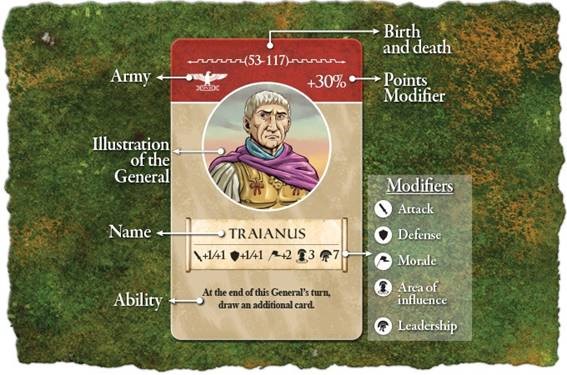
Generals give bonuses to the unit they are attached to, such as more attack or defense, more morale, etc. In addition, each General has a very unique ability, he can intimidate the enemy, improve movement in a type of terrain, activate units for free, incorporate free units to the army or activate formations. They are all very different, which makes each game unique.
Grant: What different types of terrain are there and how do they effect combat?

Luis: There is a whole additional expansion that is being offered on the Kickstarter that adds various terrain and fortresses to the battlefield. Rivers, stone or wooden walls, towers, villages, forests and hills, barricades, siege towers and much more. They provide different cover bonuses and also add in rules for sieges.
Grant: What does the actual playing surface look like?
Luis: A battlefield, with units engaged in close combat and units maneuvering to take an advantageous position. Spread around the board will be various terrain pieces as called out by the scenario.
These are some photographs of real games:

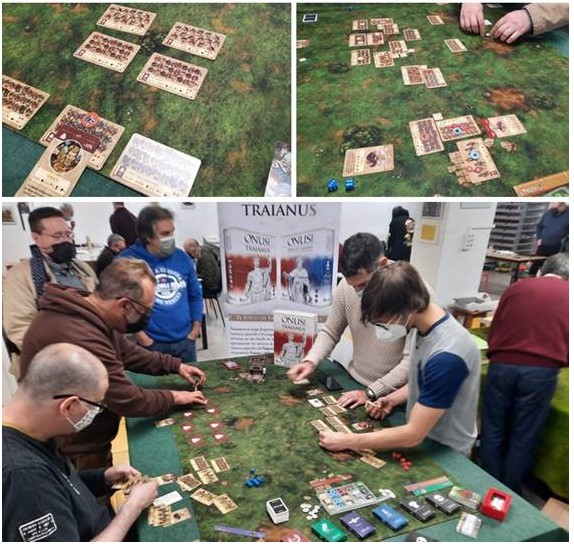
Grant: What role do mercenaries play and how do players attract their services?
Luis: They are units that can be added to any side, paying their cost. In ONUS! there are historical scenarios that can indicate that there are specific mercenaries and also battles for points in which we can choose which units to include.
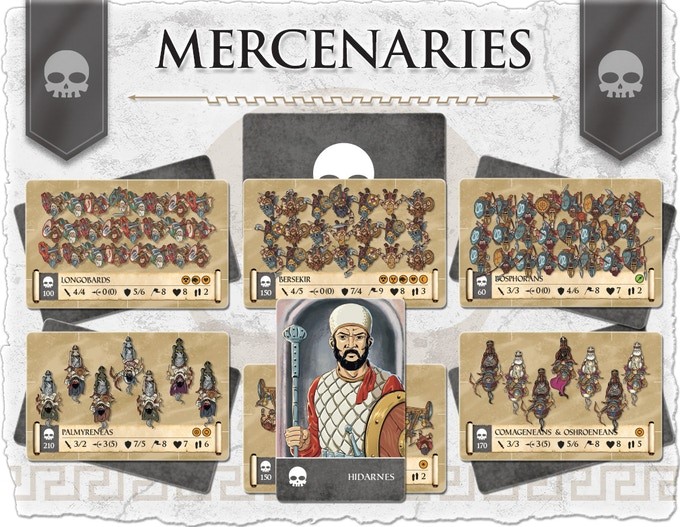
Grant: What role do Action Cards play? How many different types of Action Cards are there?

Luis: It is one of the engines of the game. We have in our hand cards that we use as orders to activate our units on the battlefield and, in addition, we will want to save them to use them as events that favor our combat.
Unlike other systems, the cards do not provide a number of points with which to activate units in exchange for not using their text. In ONUS! we use the text to activate the units indicated in it.
We can use as many as we want in a turn, but we will recover them slowly, so we will have to use them wisely.
Grant: Can you share an example of an Action Card and share their effects?
Luis: As an example, there is a card that allows us to activate all mounted units if we use it as an order. Used as an event, on the other hand, this card increases the morale and defense of a unit in melee.
Total mobilization allows us to activate all the units in this turn, losing the chance to attack with an event that gives us +2 to the attack and damage roll.
There are several copies of each order and each event, distributed in such a way that we always have to evaluate which part of the card to use and at what moment.
Grant: What special maneuvers can players utilize?
Luis: Phalanxes, shield walls, arrowheads, shield walls…There are many formations that units can adopt, each with their own advantages and disadvantages. Units can charge, rotate, and much more!
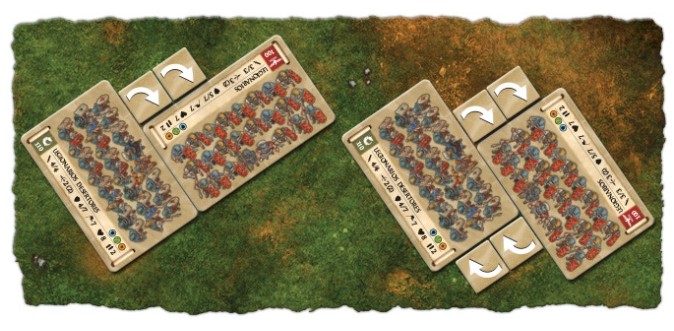
Grant: How does combat work in the design?
Luis: We believe that dice bring excitement to combat. In addition, the battlefield is not an orderly and controlled place, so the dice bring a certain amount of randomness. To the attack value of a unit we will have to add the roll of a die and overcome the defense value of the target to make a hit. For each hit we achieve, we will have to overcome its armor by making another die roll.
Grant: What are the different results from engagements for the units and formations?
Luis: Units suffer wounds, which decrease their attack capacity, but above all, they have to check morale to see if they break and start to flee.
Grant: What is the general Sequence of Play?
Luis: As simple as deciding which command cards to use for activation. Move the activated units (which includes changing their formation, rotating them, etc.), conduct combat, first ranged and then melee, check morale and do a little end-of-turn maintenance.
Grant: How many scenarios are included in the game? What is the play length of the scenarios?
Luis: The duration of each scenario or point battle will be very different, depending on the number of units involved. In addition, ONUS! allows you to play chained scenarios to form a campaign, in the same session or in different game days.
In addition to the scenarios and campaigns that are unlocked during the campaign, the two Dacian Wars will be of great importance in ONUS! Traianus:
- In the First Dacian War (101-102 A.D.) the Romans, under the command of generals such as Trajan, Laberius Maximus and Licinius Sura, will have to fight Dacians, Bastaranae and Sarmatians, led by Decebalus, Vezinas, Diegis, Susago, Inismeus and Adelmarus.
- In the Second Dacian War (105-106 A.D.) the Roman generals will again have to face the Dacians of Decebalus, after heavy defeats that finally triggered the victory of the Empire.
- You will also be able to play scenarios from the Parthian Campaign.
We are sure that during the Kickstarter campaign very interesting campaigns and scenarios are going to be unlocked that we have prepared, although they are still a surprise.
In addition, the replayability of the system is infinite, with battles for points.
Grant: What do you feel the game models well?
Luis: I think the game reflects the communication problems of the leaders with the units. Orders did not always arrive, we could not always activate all our troops. Also the chaos of the battlefield. Our elite unit can face a seemingly inferior unit but with a hero in its ranks, which may face or, on the contrary, an event may cause it to flee before engaging in combat.
Grant: What has been the experience of your playtesters?
Luis: They have helped us a lot with testing, to balance scenarios, to make the system simpler without losing depth. Each playtester has their own background, some are miniatures players, others are approaching board games for the first time, all of them allow us to see the game from different perspectives.
Grant: What are you most pleased about with the design?
Luis: The game as a whole, how the pieces fit together and form a fast game, with simple and deep rules, but above all is fun to play and engaging.
Grant: What other designs are you contemplating or already working on?
Luis: Other series of self-developed games are 2GM Tactics Wargame and SCOPE, of which we are preparing more titles. SCOPE will take us from the first installment in Stalingrad to the Atlantic in the fight of German U-boat packs attacking Allied convoys.
In addition, we are generating great alliances with other publishers to localize their games and offer them to the Spanish market. 2022 is going to be a busy year!
Grant: What stretch goals are available for the campaign?
Luis: Our policy with stretch goals is to unveil them gradually, we love to keep the suspense! We have a very low funding threshold, so we are sure that many goals will be unlocked.
In fact, we want to start with one that would be a stretch goal in another campaign, already unlocked, as a gift to all our backers: a plastic insert to order the game in the box.
In addition, during the first 48 hours, all backers will get a dice tower simulating a Roman fortress, for free!

Grant: When do you feel the game will be fulfilled and delivered?
Luis: We want to deliver it to the backers before the end of this year. We know it is a challenge, due to the current situation, but we are confident that we will achieve it, because we have been working on the game for more than two years, the tests and trials are finished and the work is very advanced, so we hope to send it to manufacture very soon after the campaign.
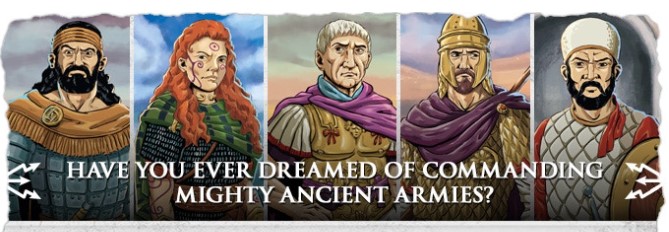
Thank you so much for your time and for your quick responses to our questions Luis. I think that the game looks really interesting and covers a period of history that I have liked gaming. I wish you luck on the Kickstarter campaign.
If you are interested in ONUS! Traianus you can order a copy on the Kickstarter page at the following link: https://www.kickstarter.com/projects/dracoideas/onus-traianus?ref=2i102x&token=eaa40ec1
-Grant
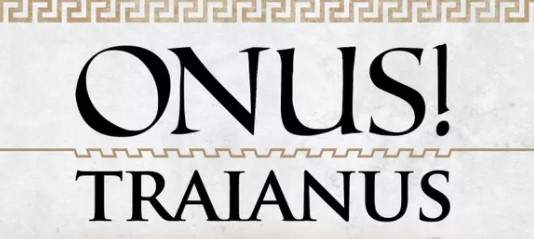
This looks brilliant!
LikeLiked by 1 person